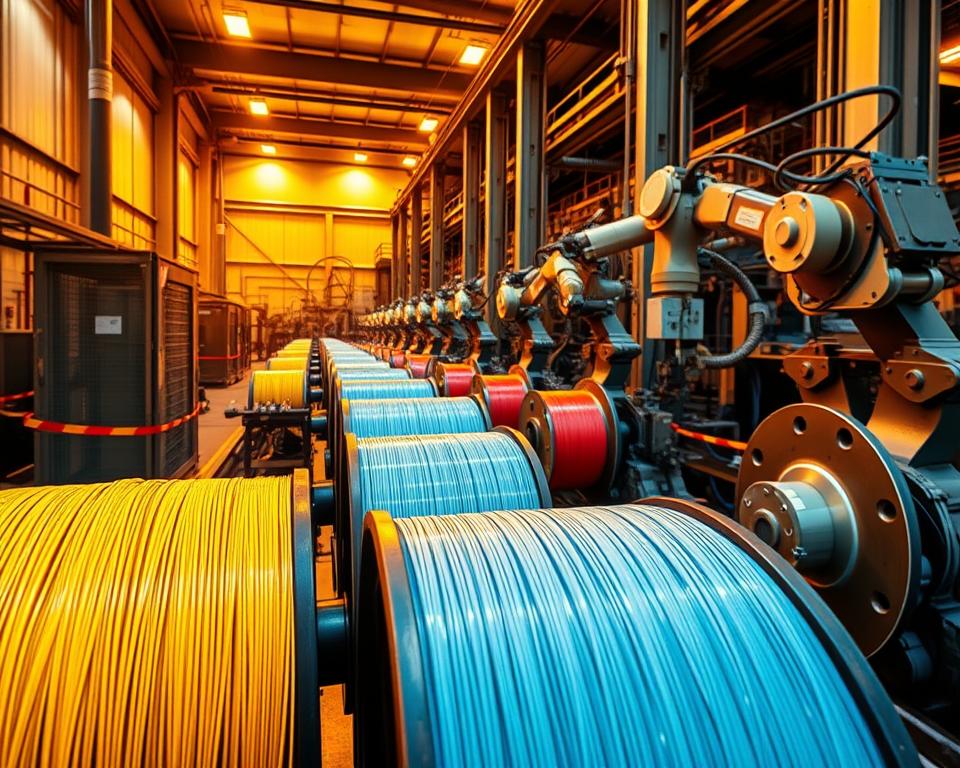Comprehending Fiber Additional Coating Lines
Did you know that exceeding 90% of global web traffic depends on optical fiber technology? This information underscores the criticality of every element in fiber optic cable fabrication, notably the fiber secondary coating line. These arrangements are vital for ensuring the fiber optic cables’ durability and effectiveness.
This piece will investigate the complexities of optical fiber secondary coating processes. We will examine their essential role in protecting fiber strands. Moreover, we will examine how these processes enhance optical fiber resilience and efficiency. This understanding is critical for those engaged in SZ stranding line industry and fabrication.
Introduction to Fiber Optic Technology
Fiber optic technology has revolutionized data transmission, using optical signals over electronic signals. This method provides high-speed communications with minimal data degradation. At the heart of this technique exist the foundations of fiber optic communications. These foundations are reinforced by a sophisticated design. It comprises a center, coating, layer, reinforcing strands, and a defensive layer. Each component is vital for the system’s functionality.
The technology’s integration into communication networks has changed our information environment. It skillfully controls large data volumes, facilitating web, telephony services, and television systems. Thus, fiber technology not only improves efficiency but also provides consistency globally.
Understanding Optical Fiber Secondary Coating Systems
A fiber secondary coating line is a assembly of specific tools and procedures. It coats shielding coats to optical fibers after production. This additional covering is essential for the fibers’ strength and operation. It shields them from external and physical dangers. The importance of coatings in maintaining fiber optics’ integrity is evident.
Definition and Importance in Optical Fiber Manufacturing
The secondary coating process is critical in fiber creation. It includes covering the fiber cores with a plastic coat. This cover protects the strands during deployment and use. It extends the durability of fibers by mitigating wear from bending, abrasion, and contaminants.
Without these coatings, strands would be susceptible to fracture and functional problems. This process is vital for preserving the optics’ strength.
The Purpose of Coverings in Safeguarding Fiber Optics
Coverings are essential in maintaining the optical and mechanical performance of fibers. They serve as a defense against physical stress and environmental conditions. The role of layers is evident; they improve the optical fiber strength. This ensures easier installation and a longer durability.
This attention to additional covering is critical for those in fiber optic technology. It’s a detail that substantially influences the optical fiber’s functionality and durability.
Parts of Optical Fiber Auxiliary Coating Systems
The optical fiber auxiliary coating system is a intricate setup, comprising several essential components. These components are key for manufacturing high-quality outputs. They clarify how a fiber secondary covering setup works and what it requires to function properly.
Key Machinery Overview
Essential equipment like fiber spoolers, gel applicators, extruders, junction units, and cooling systems constitute the center of the auxiliary coating system. Each tool is vital for the coating process. For illustration, the extruder heats the coating material, and the junction unit covers it uniformly around the strand. These parts must work together to guarantee continuous production and output excellence.
Substances in Secondary Layering
The choice of substances for covering is vital for obtaining the expected functionality. Ultraviolet-hardened acrylic substances are often selected for their excellent defensive traits. These materials safeguard the optic, boost its strength, and boost overall performance. The proper blend of materials guarantees the final product conforms to industry standards and client demands.
Exploring the Auxiliary Covering Operation
The auxiliary covering operation is vital in the production of fiber strands, providing crucial protection to the newly drawn fibers. This step involves the application of protective materials to improve the fiber strand’s strength and functionality. The schedule of this operation is vital; it guarantees perfect bonding, thus minimizing material loss and improving manufacturing productivity.
Manufacturers use multiple layering techniques, like polymer application and gel layering, to adjust particular covering characteristics and thicknesses. Each method brings unique benefits, appropriate for various optic uses and needs. As the demand for superior optical fibers grows, enhancing the auxiliary covering operation is crucial. It is vital for upholding sector norms and advancing coating technology.
Significance of the Draw Tower in Auxiliary Covering
The fiber strand extraction system is vital in the manufacturing of optical fibers. It draws fibers from preforms while coating with protective substances as they solidify. The quality of the drawing system is vital, impacting the layering’s success.
Operation of the Extraction Structure
The extraction structure raises the temperature of the initial shape before drawing the fiber at a managed rate. This procedure is crucial for upholding the optic’s strength. As the strand comes out, coatings are applied instantly for consistent shielding against external and physical harm. The layout of the drawing setup provides ideal covering placement sequence and attachment.
Relationship Between Draw Tower and Coating Quality
The draw tower’s quality directly influences the coating’s final result. Inconsistencies in the extraction operation can result in irregular layering dimensions, affecting the fiber strand’s effectiveness. Top-notch extraction structures remove these problems. A uniform coating configuration improves physical strength, making the fiber draw tower more durable and useful in diverse operations.
Traits of Superior Auxiliary Coverings
High-quality coatings are crucial for the functionality and dependability of optical fiber networks. They must adhere to rigid physical and light transmission benchmarks to provide data transmission efficiency. This awareness supports fabricators in designing more dependable products.
Physical Strength and Light Transmission Guidelines
Auxiliary coverings need to demonstrate outstanding mechanical properties. They must resist physical stress and preserve effectiveness across various environmental conditions. This requires adhering well to the glass core and preventing contraction or stretching. Additionally, they should improve visual transparency, ensuring rapid communication with reduced data degradation.
Relevance of Attachment and Prevention of Coating Detachment
Adhesion of the coating to the glass core is vital for the network’s durability. Without firm bonding, the likelihood of layer separation rises, likely resulting in breakdowns. Top-tier coverings are engineered to resist delamination, guaranteeing durability and reliability across different applications. This resilience not only prolongs the fiber strand’s longevity but also enhances functionality, underscoring the need for selecting superior coating materials.
Advancements in Secondary Layering Processes
The evolution of secondary layering processes is pushed by the quest for effectiveness and superior product quality. In the fiber optics market, the embracing of advanced covering tools is growing. These developments feature real-time monitoring systems and better polymer applicators. Such tools enable producers to uphold top-tier benchmarks while streamlining production processes.
Advances in Auxiliary Covering Tools
New developments in secondary layering processes have revolutionized manufacturing capabilities. New extruder systems now offer precise control over the layering procedure. This causes better consistency and functionality in the final product. Mechanization and smart technology integration additionally facilitate faster production cycles with reduced human intervention. This not only cuts down on faults but also boosts overall output.
Comparison of Different Secondary Coating Line Technologies
Juxtaposing multiple secondary layering methods is crucial. Flexible setups stand out for their flexibility and expandability. They allow manufacturers to respond to variable fabrication requirements without major system modifications. In comparison, conventional systems are renowned for their reliability and established performance. The decision on method is based on a company’s specific needs, budget, and manufacturing objectives.
Advantages of Using Secondary Coating Lines
Auxiliary covering systems offer multiple advantages to manufacturers in the fiber optics market. They boost the manufacturing operation, causing higher cost-effectiveness and better quality outputs.
Cost-Efficiency in Production
Auxiliary covering systems are essential to cutting manufacturing expenses. They reduce excess material and streamline operations, leading to significant cost efficiency. This efficiency increases financial returns, making it vital for businesses aiming to stay competitive.
Enhanced Output Standards and Longevity
Secondary layering processes also elevate product quality. The long-lasting layers added through these lines improve the output longevity of fiber optic cables. This translates to longer lifespan and consistency, guaranteeing superior performance and customer happiness.
Uses of Auxiliary Covering Systems
Optical fiber auxiliary covering systems are essential across multiple fields, guaranteeing the dependability and functionality of fiber optics. These strands are crucial in communication networks, building the base for high-speed internet services. They support effective information transfer, linking clients across the globe.
In the medical sector, these optics are crucial for operational devices and evaluation tools. Their precision and resilience are essential for clinical operations. The applications of fiber secondary coating also extend to aviation and military, where they improve network setups and sensor technologies.
Consumer electronics reap advantages from the improved strength of these strands. They back devices that operate under harsh conditions. The versatility of these fibers enables creative developments, making them vital in today’s contemporary technological environment.
Effect of Auxiliary Covering on Optical Fiber Functionality
The secondary layering is vital for boosting fiber optic performance, focusing on tensile strength and light distortion. A expertly applied layer can substantially lower tiny imperfections in optics that could cause failure under stress.
How Coatings Affect Tensile Strength
The tensile strength of fiber optics is essential for their consistency across different uses. Additional layers deliver a protective layer that absorbs stress, minimizing the chance of fracture. This defensive cover guarantees that strands maintain their fiber durability under environmental conditions, providing consistent performance over time.
Microbending Performance and Its Importance
Microbending effects can alter optical paths within fiber strands, causing signal degradation. Powerful secondary layers reduce these bending issues, ensuring strands retain their optical properties even in harsh environments. By minimizing light distortion, manufacturers can guarantee optical fiber strands provide top-notch functionality and strength throughout their lifespan.
Market Trends and Innovations in Fiber Secondary Coating
The fiber secondary coating sector is witnessing significant shifts, propelled by the requirement for improved functionality and eco-friendliness. This progress is driven by the rapid expansion of data transfer, heightening focus on the need for superior substances and cutting-edge covering techniques. These developments emphasize the necessity of adopting high-tech substances and techniques in the coating industry.
New Developments in Covering Methods
Advancements in coating technology have resulted in the development of innovative synthetic compounds. These materials boast advanced structural traits and eco-friendliness. Such advancements not only enhance the durability of fiber optics but also minimize environmental harm. Furthermore, advanced fabrication processes guarantee higher precision in application, resulting in consistent product quality.
Forecast for Secondary Layering Processes
The forecast for secondary layering processes is anticipated to include the adoption of mechanization and advanced systems. These innovations are projected to optimize fabrication, thus reducing costs and boosting item excellence. As the market continues to evolve, the emphasis will stay on research and development. This will fuel additional developments aimed at satisfying the need for fast information exchange and energy efficiency.
Challenges Faced in Fiber Optic Coating
The manufacturing of fiber optic coatings faces numerous challenges that impact production efficiency and item excellence. A significant challenge is the difficulty in maintaining consistent coating thickness across various fiber types. Such differences can cause coating complications, impacting the fiber strands’ total effectiveness and reliability.
Achieving strong bonding between the layer and the strand is another vital obstacle. Insufficient attachment can lead to the coating to fail early, whether in the initial stages or later in use. Additionally, contaminants during the coating process create substantial fabrication challenges. These impurities can compromise the covering’s strength and performance. Producers must manage complying with tough eco-rules with advances in manufacturing to get past these challenges.
Resolving these issues is vital to fulfill the rising sector expectations. It sets the stage for better longevity and consistency in optical fiber uses.
Overview of Secondary Layering Processes
The summary of optical fiber auxiliary covering systems highlights their crucial role in producing reliable and top-notch optical fiber strands. These setups not only boost the structural and optical qualities of fiber strands but also protect them from external dangers. This provides the cables remain intact over their functional period.
Advancements in technology have taken the benefits of FTTH cable production line to greater levels. They improve manufacturing productivity, reduce excess, and lead to better output standards. The innovations enable firmer attachment and resistance to issues like delamination, which crucially affects effectiveness.
Grasping the significance of secondary layering processes helps those involved in the optical fiber industry make educated decisions. This knowledge causes enhanced item availability and fabrication effectiveness. Such improvements are crucial in today’s competitive market.
Frequently Asked Questions
Definition of a fiber secondary coating line?
A secondary layering process is a system meant to coat with defensive layers to optical fibers. This procedure occurs after drawing, guaranteeing the optics’ strength and functionality.
Why is secondary layering essential in fiber strand fabrication?
The secondary layering procedure is vital. It defends the optics from mechanical and environmental risks. This enhances their longevity and reliability, while upholding their visual characteristics.
What are the main components of a fiber secondary coating line?
Primary elements include optical fiber feeders, gel dispensers, coating machines, crossheads, and temperature control systems. These components work together efficiently to coat with defensive layers to fiber optics.
Common substances in auxiliary covering?
Common materials include UV-cured acrylate polymers. These deliver a defensive cover against wear from curving, scuffing, and impurities.
Impact of the drawing system on secondary layering?
The fiber strand extraction system controls the fibers’ drawing from preforms and applies coating materials as they cool. This significantly influences the coating quality.
Physical strength and light transmission guidelines for auxiliary coverings?
Additional layers must stick firmly to the optic’s center, avoid coating detachment, and endure mechanical pressure. This boosts the optic resilience and light transmission of the fiber optic cables.
Innovative techniques in auxiliary covering systems?
Innovative techniques include advanced extruder systems and live tracking for ensuring standards. These innovations boost layering functionality and fabrication effectiveness.
What advantages do secondary coating lines offer manufacturers?
Auxiliary covering systems lead to cost efficiencies in production, better output standards, minimized excess, and increased durability and performance of optical fiber strands.
In which industries are fiber secondary coating lines used?
These processes are applied in telecoms, medical, aviation, and consumer electronics. They provide reliable fibers for high-speed internet services and data centers.
How do secondary coatings impact the tensile strength of optical fibers?
Additional layers shield small defects and mitigate microbending effects. This provides the fiber strands preserve their visual properties and perform consistently under various conditions.
What are the current challenges faced in fiber optic coating manufacturing?
Manufacturers encounter obstacles like ensuring uniform covering depth, maintaining firm attachment, avoiding pollutants, and meeting environmental standards while driving progress.
Upcoming developments in auxiliary covering industry?
The market is expected to see increased automation, advanced system combination, and advancements in polymer materials. These will enhance environmental sustainability and layering functionality.



